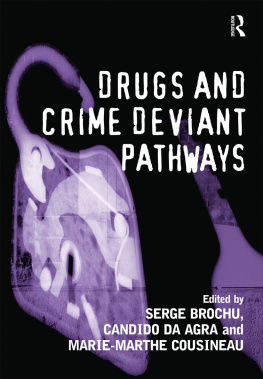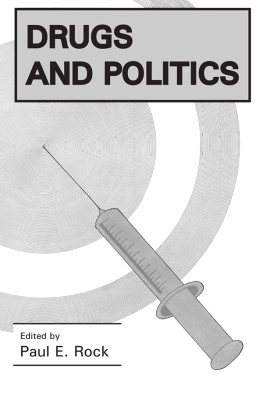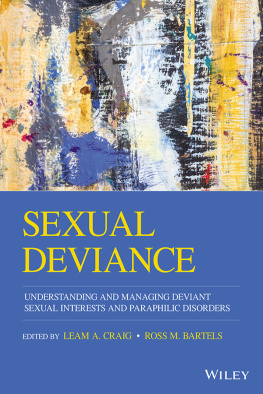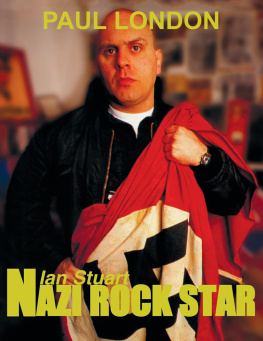Routledge Revivals
Deviant Behaviour
This book, first published in 1973, explores the manner in which conceptions of deviancy arise and shows how the attitudes of non-deviants, of society and of authority, are as instrumental in forming these conceptions as the actions of the deviants themselves. Chapters include discussions on the definition of deviants and deviancy and the enforcement of the law, alongside a detailed introduction. This title will be of particular value to students and scholars with an interest in criminology and the sociology and psychology of deviancy.
Deviant Behaviour
Paul Rock
First published in 1973
by Hutchinson & Co
This edition first published in 2013 by Routledge
2 Park Square, Milton Park, Abingdon, Oxon, OX14 4RN
Simultaneously published in the USA and Canada
by Routledge
711 Third Avenue, New York, NY 10017
Routledge is an imprint of the Taylor & Francis Group, an informa business
1973 Paul Rock
All rights reserved. No part of this book may be reprinted or reproduced or utilised in any form or by any electronic, mechanical, or other means, now known or hereafter invented, including photocopying and recording, or in any information storage or retrieval system, without permission in writing from the publishers.
Publishers Note
The publisher has gone to great lengths to ensure the quality of this reprint but points out that some imperfections in the original copies may be apparent.
Disclaimer
The publisher has made every effort to trace copyright holders and welcomes correspondence from those they have been unable to contact.
A Library of Congress record exists under LC control number: 73173728
ISBN 13: 978-0-415-70899-9 (hbk)
ISBN 13: 978-1-315-88582-7 (ebk)
DEVIANT BEHAVIOUR
Paul Rock
HUTCHINSON & CO (Publishers) LTD
3 Fitzroy Square, London W1
London Melbourne Sydney Auckland
Wellington Johannesburg Cape Town
and agencies throughout the world
First published 1973
The paperback edition of this book is sold subject to the condition that it shall not, by way of trade or otherwise, be lent, resold, hired out, or otherwise circulated without the publishers prior consent, in any form of binding or cover other than that in which it is published and without a similar condition including this condition being imposed on the subsequent purchaser
Paul Rock 1973
This book has been set in Times type, printed in Great Britain on smooth wove paper by The Camelot Press Ltd, London and Southampton, and bound by Wm. Brendon, of Tiptree, Essex
ISBN 0 09 115440 5 (cased)
0 09 115441 3 (paper)
CONTENTS
This book is a crystallisation of ideas which emerged from two settings. First, I am enormously indebted to members of the National Deviancy Conference; and although they will probably disown many of the perspectives which I have adopted, our meetings led me to structure what I had initially experienced as no more than a set of intuitions. The other setting was the graduate seminar held by David Downes, Frances Heidensohn and myself at the London School of Economics between 1969 and 1970. The book was originally conceived as a joint work to be written by Frances Heidensohn and me: it is a great pity that she was unable to collaborate. Kit Carson and Bill Chambliss were most helpful in commenting on sections of the book, as was Percy Cohen, who suggested it in the first place.
I am grateful to the following for permission to use copyright material: Basic Book, Inc., Publishers, New York, from Deviance and Respectability: The Social Construction of Moral Meanings, Ed. Jack D. Douglas, 1970; the Free Press, New York, from The Other Side, Ed. H. Becker, 1964, and from The Legislation of Morality by T. Duster, 1970; Martinus Nijhoff, The Hague, from Alfred Schutz: Collected Papers, Ed. M. Natanson, 1967; John Wiley & Sons, Inc., from The Police: Six Sociological Essays, Ed. David J. Bordua, 1967.
Crouch End
P. R.
The study of crime has conventionally dwelt on the pathology of the individual offender or on the groups in which he organises his behaviour. Heavily dominated by a statistical approach, it was never the peculiar province of any one discipline. Psychology, psychoanalysis, anthropology, law, applied statistics and sociology all laid claim to criminology. Many criminologists were tacitly committed to multidisciplinary syntheses1 whose goals were dictated by practical correctional objectives rather than the refinement of theoretical understanding.2 The rules, whose infringement constituted deviancy, were simply taken for granted. They were not only absolute but also unproblematic. Similarly, social control and nondeviant behaviour were treated as only the backcloth against which pathology was displayed. They were discrete, isolated and unworthy of analysis.
In the main, criminology has been estranged from prevailing sociological concerns and stances. It has bracketed or ignored vast areas of social process which any practising sociologist would consider integrally linked to criminal behaviour. Disregard has largely been exchanged. Social rules, deviancy and formal agencies of control have never been of much interest to sociologists. Most sociologists would be ashamed to know nothing about academic writings on religion, politics or development. It is not a matter of professional shame to be devoid of competence in the field of deviancy theory.3
Of course, there have been abundant exceptions to the general alienation of criminology: instances are Durkheims preoccupation with moral order and deviancy; occasional ethnographic studies such as Whytes Streetcorner Society; the structural-functionalist work of Parsons, Merton, Cohen, Cloward and Ohlin; the Chicago ecologists; and sophisticated institutional studies of prison structure. Above all, there has been the continuous but slender tradition of thought which originated (arbitrarily) in Simmel, and continued through Park and the Chicago School, Tannenbaum, Sutherland, Cressey and, most important, Lemert. The tradition ultimately developed into what has been called the interactionist sociology of deviancy. Interactionism was not itself markedly sophisticated, but it did galvanise criminology. Its chief significance was the transformation of criminology into the sociology of deviancy. The change denoted a shift in the nature of the substantive area studied. Crime simply became one of a number of rule-breaking phenomena whose particular characteristic was the infraction of criminal law. The invocation of criminal law as a means of social control became an event worthy of explanation in its own right. Social control became the chief focus and its connections with power became salient.
The change connoted a redefinition of crime and deviancy as social occurrences which can be studied with conventional sociological concepts and techniques. Deviancy is a widespread activity and, a priori















